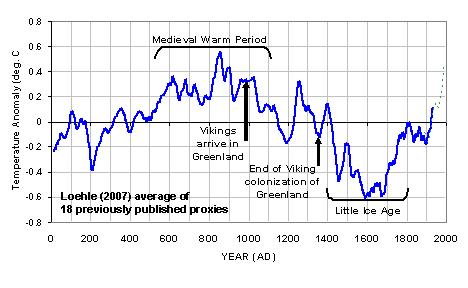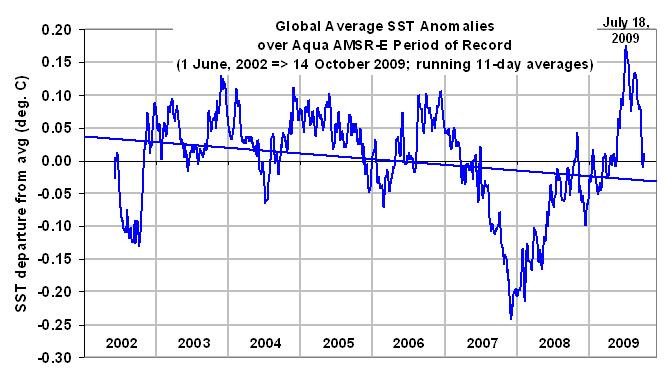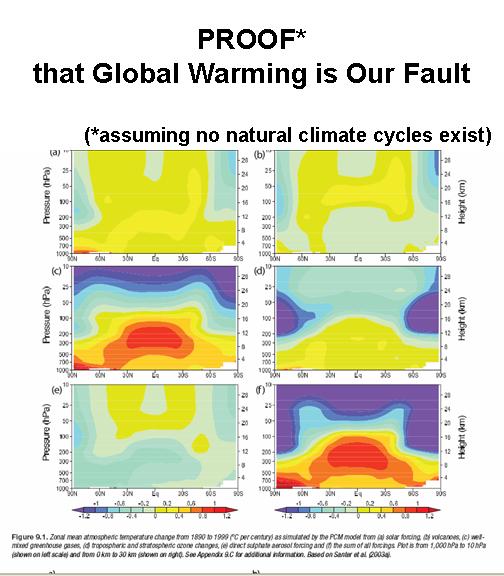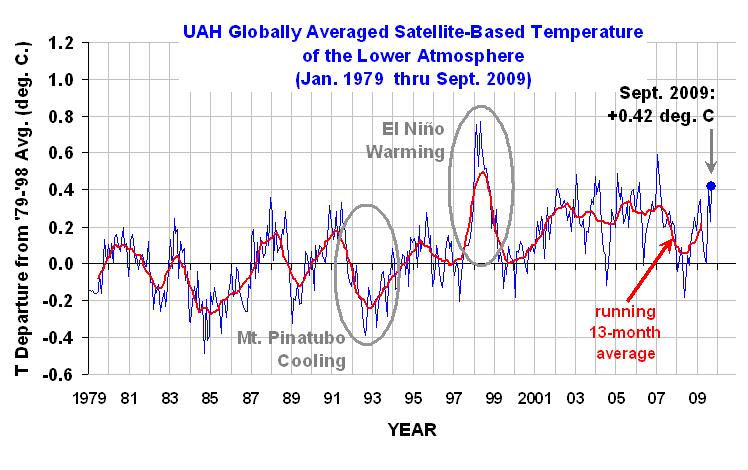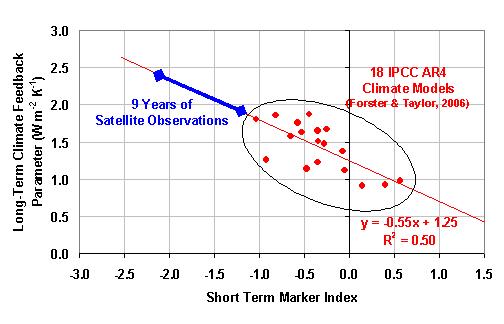About.com describes an “urban legend” as an apocryphal (of questionable authenticity), secondhand story, told as true and just plausible enough to be believed, about some horrific…series of events….it’s likely to be framed as a cautionary tale. Whether factual or not, an urban legend is meant to be believed. In lieu of evidence, however, the teller of an urban legend is apt to rely on skillful storytelling and reference to putatively trustworthy sources.
I contend that the belief in human-caused global warming as a dangerous event, either now or in the future, has most of the characteristics of an urban legend. Like other urban legends, it is based upon an element of truth. Carbon dioxide is a greenhouse gas whose concentration in the atmosphere is increasing, and since greenhouse gases warm the lower atmosphere, more CO2 can be expected, at least theoretically, to result in some level of warming.
But skillful storytelling has elevated the danger from a theoretical one to one of near-certainty. The actual scientific basis for the plausible hypothesis that humans could be responsible for most recent warming is contained in the cautious scientific language of many scientific papers. Unfortunately, most of the uncertainties and caveats are then minimized with artfully designed prose contained in the Summary for Policymakers (SP) portion of the report of the UN’s Intergovernmental Panel on Climate Change (IPCC). This Summary was clearly meant to instill maximum alarm from a minimum amount of direct evidence.
Next, politicians seized upon the SP, further simplifying and extrapolating its claims to the level of a “climate crisis”. Other politicians embellished the tale even more by claiming they “saw” global warming in Greenland as if it was a sighting of Sasquatch, or that they felt it when they fly in airplanes.
Just as the tales of marauding colonies of alligators living in New York City sewers are based upon some kernel of truth, so too is the science behind anthropogenic global warming. But there is a big difference between reports of people finding pet alligators that have escaped their owners, versus city workers having their limbs torn off by roving colonies of subterranean monsters.
In the case of global warming, the “putatively trustworthy sources” would be the consensus of the world’s scientists. The scientific consensus, after all, says that global warming is…is what? Is happening? Is severe? Is manmade? Is going to burn the Earth up if we do not act? It turns out that those who claim consensus either do not explicitly state what that consensus is about, or they make up something that supports their preconceived notions.
If the consensus is that the presence of humans on Earth has some influence on the climate system, then I would have to even include myself in that consensus. After all, the same thing can be said of the presence of trees on Earth, and hopefully we have at least the same rights as trees do. But too often the consensus is some vague, fill-in-the-blank, implied assumption where the definition of “climate change” includes the phrase “humans are evil”.
It is a peculiar development that scientific truth is now decided through voting. A relatively recent survey of climate scientists who do climate research found that 97.4% agreed that humans have a “significant” effect on climate. But the way the survey question was phrased borders on meaninglessness. To a scientist, “significant” often means non-zero. The survey results would have been quite different if the question was, “Do you believe that natural cycles in the climate system have been sufficiently researched to exclude them as a potential cause of most of our recent warming?”
And it is also a good bet that 100% of those scientists surveyed were funded by the government only after they submitted research proposals which implicitly or explicitly stated they believed in anthropogenic global warming to begin with. If you submit a research proposal to look for alternative explanations for global warming (say, natural climate cycles), it is virtually guaranteed you will not get funded. Is it any wonder that scientists who are required to accept the current scientific orthodoxy in order to receive continued funding, then later agree with that orthodoxy when surveyed? Well, duh.
In my experience, the public has the mistaken impression that a lot of climate research has gone into the search for alternative explanations for warming. They are astounded when I tell them that virtually no research has been performed into the possibility that warming is just part of a natural cycle generated within the climate system itself.
Too often the consensus is implied to be that global warming is so serious that we must do something now in the form of public policy to avert global catastrophe. What? You don’t believe that there are alligators in New York City sewer system? How can you be so unconcerned about the welfare of city workers that have to risk their lives by going down there every day? What are you, some kind of Holocaust-denying, Neanderthal flat-Earther?
It makes complete sense that in this modern era of scientific advances and inventions that we would so readily embrace a compelling tale of global catastrophe resulting from our own excesses. It’s not a new genre of storytelling, of course, as there were many B-movies in the 1950s whose horror themes were influenced by scientists’ development of the atomic bomb.
Our modern equivalent is the 2004 movie, “Day After Tomorrow”, in which all kinds of physically impossible climatic events occur in a matter of days. In one scene, super-cold stratospheric air descends to the Earth’s surface, instantly freezing everything in its path. The meteorological truth, however, is just the opposite. If you were to bring stratospheric air down to the surface, heating by compression would make it warmer than the surrounding air, not colder.
I’m sure it is just coincidence that “Day After Tomorrow” was directed by Roland Emmerich, who also directed the 1996 movie “Independence Day,” in which an alien invasion nearly exterminates humanity. After all, what’s the difference? Aliens purposely killing off humans, or humans accidentally killing off humans? Either way, we all die.
But a global warming catastrophe is so much more believable. After all, climate change does happen, right? So why not claim that ALL climate change is now the result of human activity? And while we are at it, let’s re-write climate history so that we get rid of the Medieval Warm Period and the Little Ice age, with a new ingenious hockey stick-shaped reconstruction of past temperatures that makes it look like climate never changed until the 20th Century? How cool would that be?
The IPCC thought it was way cool…until it was debunked, after which it was quietly downgraded in the IPCC reports from the poster child for anthropogenic global warming, to one possible interpretation of past climate.
And let’s even go further and suppose that the climate system is so precariously balanced that our injection of a little bit of that evil plant food, carbon dioxide, pushes our world over the edge, past all kinds of imaginary tipping points, with the Greenland ice sheet melting away, and swarms of earthquakes being the price of our indiscretions.
In December, hundreds of bureaucrats from around the world will once again assemble, this time in Copenhagen, in their attempts to forge a new international agreement to reduce greenhouse gas emissions as a successor to the Kyoto Protocol. And as has been the case with every other UN meeting of its type, the participants simply assume that the urban legend is true. Indeed, these politicians and governmental representatives need it to be true. Their careers and political power now depend upon it.
And the fact that they hold their meetings in all of the best tourist destinations in the world, enjoying the finest exotic foods, suggests that they do not expect to ever have to be personally inconvenienced by whatever restrictions they try to impose on the rest of humanity.
If you present these people with evidence that the global warming crisis might well be a false alarm, you are rewarded with hostility and insults, rather than expressions of relief. The same can be said for most lay believers of the urban legend. I say “most” because I once encountered a true believer who said he hoped my research into the possibility that climate change is mostly natural will eventually be proved correct.
Unfortunately, just as we are irresistibly drawn to disasters – either real ones on the evening news, or ones we pay to watch in movie theaters – the urban legend of a climate crisis will persist, being believed by those whose politics and worldviews depend upon it. Only when they finally realize what a new treaty will cost them in loss of freedoms and standard of living will those who oppose our continuing use of carbon-based energy begin to lose their religion.

 Home/Blog
Home/Blog